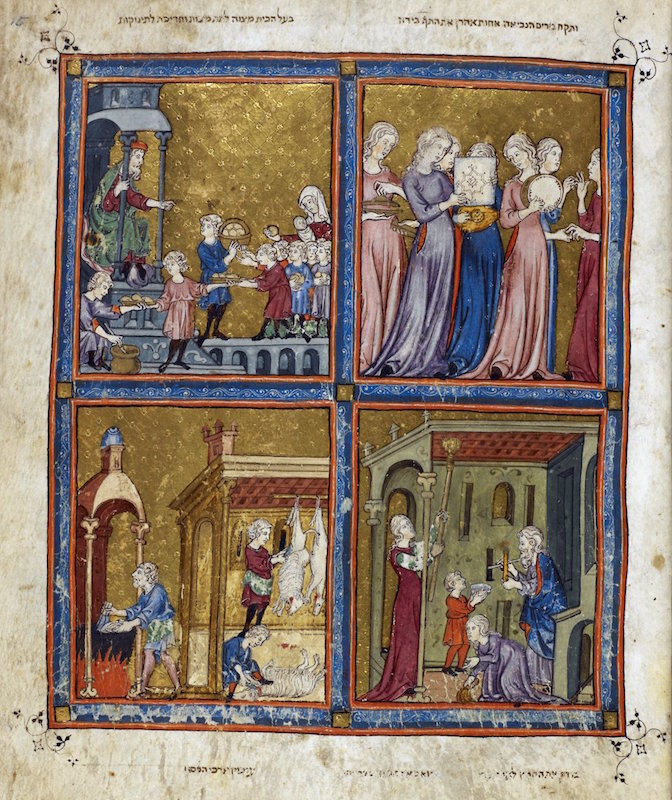
The preparation for the Passover festival: upper right: Miriam (Moses’ sister), holding a timbrel decorated with an Islamic motif, is joined by maidens dancing and playing contemporary musical instruments; upper left: the master of the house, sitting under a canopy, orders the distribution of matzoh (unleavened bread) and haroset (a sweet made from nuts and fruit) to the children; lower right: the house is prepared for Passover, the man holding a candle searches for leavened bread on the night before Passover and the woman and girl clean; bottom left: sheep are slaughtered for Passover and a man purifies utensils in a cauldron over a fire. From the Golden Haggadah, c. 1320, northern Spain, probably Barcelona (British Library, MS. 27210, fol. 15 recto)
On the eve of the Jewish holiday of Passover, a child traditionally asks a critical question: “Why is this night different from all other nights?” This question sets up the ritual narration of the story of Passover, when Moses led the Jews out of slavery in Egypt with a series of miraculous events (recounted in the Jewish Bible in the book of Exodus).
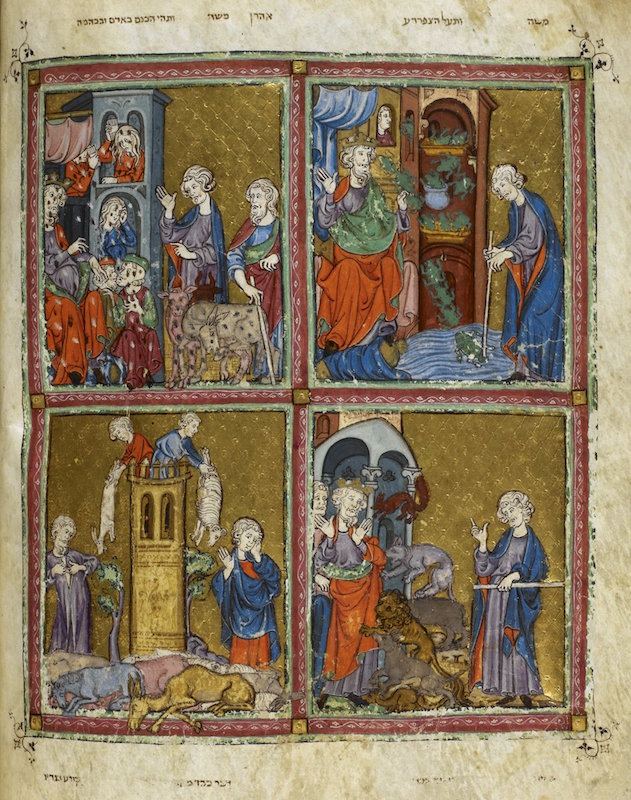
Four plagues (clockwise from top left): painful boils afflict the Egyptians, swarms of frogs overrun the land, pestilence kills the domestic animals and wild animals invade the city. From the Golden Haggadah, c. 1320, northern Spain, probably Barcelona (British Library, MS. 27210, fol. 12 verso)
For the last and most terrible in a series of miraculous plagues that ultimately convinced the Egyptian Pharaoh to free the Jews—the death of the first born sons of Egypt—Moses commanded the Jews to paint a red mark on their doors. In doing so, the Angel of Death “passed over” these homes and the children survived. The story of Passover—of miraculous salvation from slavery—is one that is recounted annually by many Jews at a seder, the ritual meal that marks the beginning of the holiday.
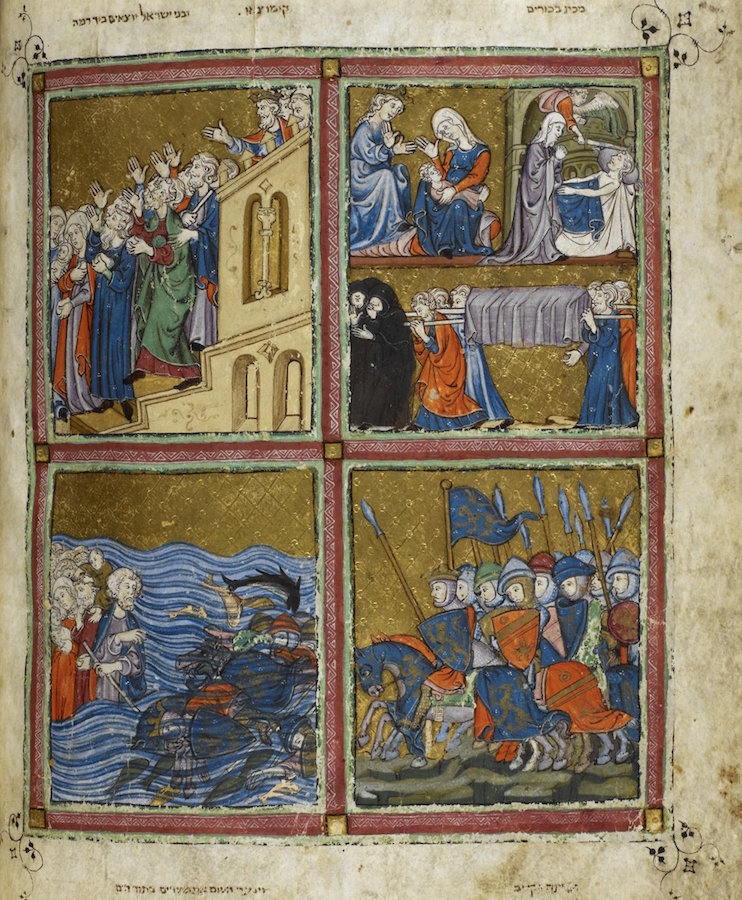
The plague of the first-born: in the upper-right corner, three scenes: an angel strikes a man, the queen mourns her baby, and the funeral of the first-born; upper left: Pharaoh orders the Israelites to leave Egypt, the Israelites, holding lumps of dough, walk with hands raised illustrating the verse: “And the children of Israel went out with a high hand”; bottom right: pursuing Egyptians are shown as contemporary knights led by a king; bottom left: the Israelites’ safely cross the Red Sea, Moses takes a last look at the drowning Egyptians. From the Golden Haggadah, c. 1320, northern Spain Plagues (clockwise from top left), probably Barcelona (British Library, MS. 27210, fol. 14 verso)
A luxurious book
The book used to tell the story of Passover around the seder table each year is a special one, known as a haggadah (haggadot, pl). The Golden Haggadah, as you might imagine given its name, is one of the most luxurious examples of these books ever created. In fact, it is one of the most luxurious examples of a medieval illuminated manuscript, regardless of use or patronage. So although the Golden Hagaddah has a practical purpose, it is also a fine work of art used to signal the wealth of its owners.
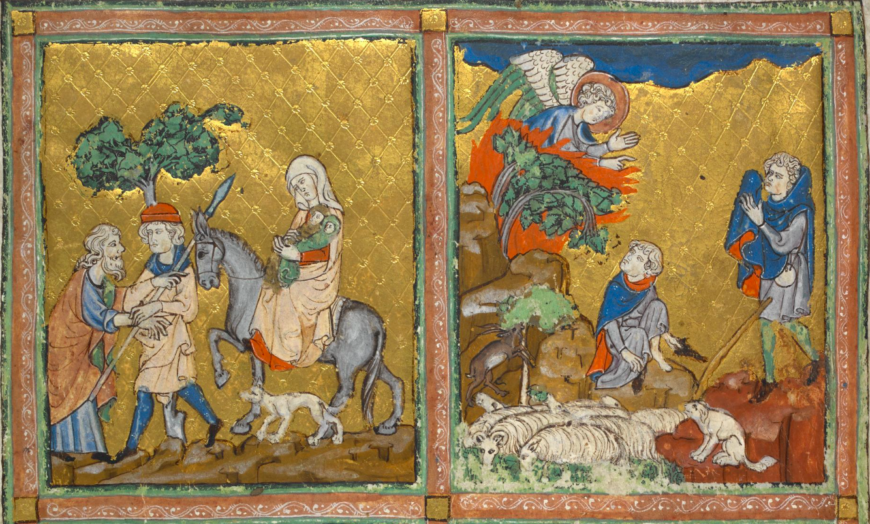
Left: Taking his family back to Egypt, Moses meets Aaron on the way and Zipporah, holding two babies in her arms, rides a mule; right: an angel appears above the bush that burns but is not consumed and on divine instructions, Moses takes off his shoes and hides his face when he hears the voice of God. Upper part of a page from the Golden Haggadah, c. 1320, Northern Spain, probably Barcelona (British Library, MS. 27210, fol. 10 verso)
A hagaddah usually includes the prayers and readings said during the meal and sometimes contained images that could have served as a sort of pictorial aid to envision the history of Passover around the table. In fact, the word “haggadah” actually means “narration” in Hebrew. The Golden Haggadah is one of the most lavishly decorated medieval Haggadot, containing 56 miniatures (small paintings) found within the manuscript. The reason it is called the “Golden” Haggadah is clear—each miniature is decorated with a brilliant gold-leaf background. As such, this manuscript would have been quite expensive to produce and was certainly owned by a wealthy Jewish family. So although many haggadot show signs of use—splashes of wine, etc.—the fine condition of this particular haggadah means that it might have served a more ceremonial purpose, intended to showcase the prosperity of this family living near Barcelona in the early fourteenth century.
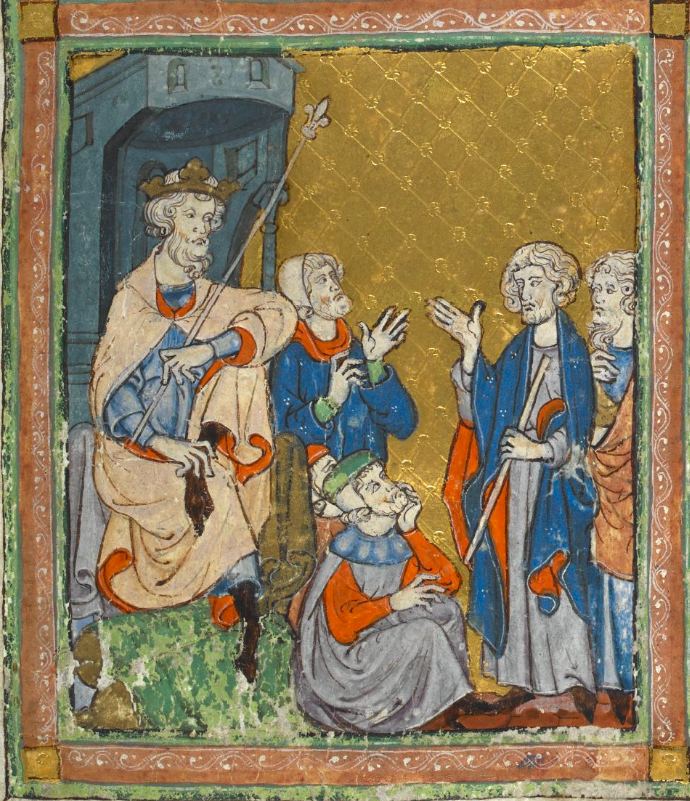
Moses and Aaron come before Pharaoh, from the Golden Haggadah, c. 1320, Northern Spain, probably Barcelona (British Library, MS. 27210, fol. 10 verso)
Gothic in style
The fact that the Golden Haggadah was so richly illuminated is important. Although the second commandment in Judaism forbids the making of “graven images,” haggadot were often seen as education rather than religious and therefore exempt from this rule.
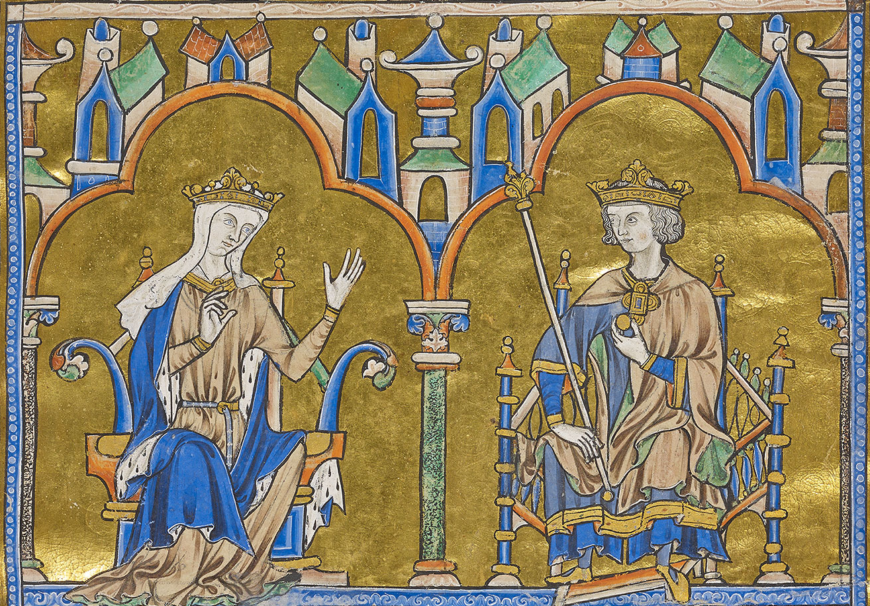
Blanche of Castile and King Louis IX of France (detail), Dedication Page with Blanche of Castile and King Louis IX of France, Bible of Saint Louis (Moralized Bible), c. 1227–34, ink, tempera, and gold leaf on vellum (The Morgan Library and Museum, MS M. 240, fol. 8).
The style of the manuscript may look familiar to you—it is very similar to Christian Gothic manuscripts such as the Bible of Saint Louis. Look, for example, at the figure of Moses and the Pharaoh (above). He doesn’t really look like an Egyptian pharaoh at all but more like a French king. The long flowing body, small architectural details and patterned background reveal that this manuscript was created during the Gothic period. Whether the artists of the Golden Haggadah themselves were Jewish is open to debate, although it is certainly evident that regardless of their religious beliefs, the dominant style of Christian art in Europe clearly influenced the artists of this manuscript.
Cross-cultural styles
So the Golden Haggadah is both stylistically an example of Jewish art and Gothic art. Often Christian art is associated with the Gothic style but it is important to remember that artists, regardless of faith, were exchanging ideas and techniques. In fact, while the Golden Haggadah looks Christian (Gothic) in style, other examples of Jewish manuscripts, such as the Sarajevo Haggadah, blend both Christian and Islamic influences. This cross-cultural borrowing of artistic styles happened throughout Europe, but was especially strong in medieval Spain and Portugal, where Jews, Christians and Muslims lived together for many centuries. Despite periods of persecution, the Jews of Spain, known as Sephardic Jews, developed a rich culture of Judaism on the Iberian Peninsula (Spain and Portugal). The Golden Haggadah thus stands as a testament to the impact and significance of Jewish culture in medieval Spain—and the rich multicultural atmosphere of that produced such a magnificent manuscript.




